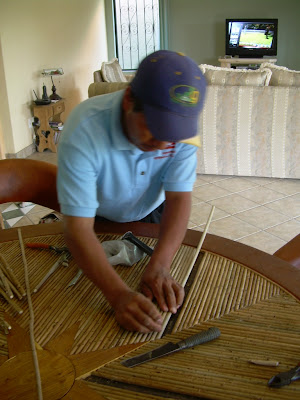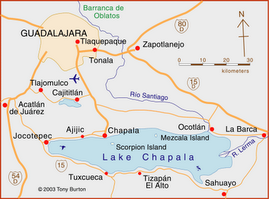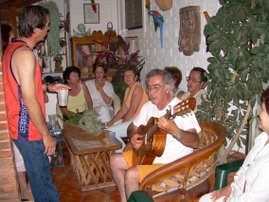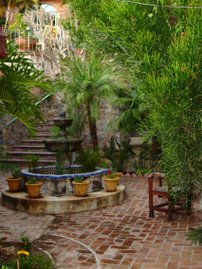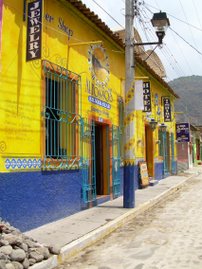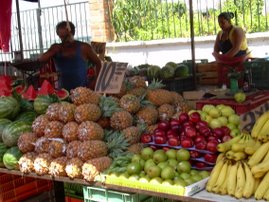
We have decided to name our house, "Casa de la Paz," or "House of Peace." It is a peaceful refuge for us, and we look forward to many years of love and peace here in our new Mexican home. We will have this new plaque cemented in our front wall to replace the one that now says, "The Murrays." We are continuing to make progress on furnishing the house. Lynn and Gary have graciously agreed to lend us some furniture to use while they return to the US to work for awhile. We are storing some of their stuff in our bodega, and we will miss them dearly. Below is a bittersweet picture of them on their last visit to our house before they left:

I am leaving on April 22 to join Pixie in Indiana, and from there we will visit Philadelphia, Providence, and Maine. We will both be returning to Mexico on May 20. Since I will be on the road for about a month, I will not post on this blog again until we return. However, since we are about ready to complete our first year in Mexico, I thought it would be appropriate to check in and see whether some myths about living in Mexico (which people mentioned to us before we came) have turned out to be true.
Living in Mexico is cheaper.
This is generally true, with a few caveats. Certainly living in the Lake Chapala area is not nearly as cheap as living in other areas of Mexico, but then, there is a lot to offer here. Real estate is not much cheaper than the United States. Just check out real estate websites and see. A lot of the expense of living here is up to you. If you rent or buy a modest home, use Mexican products instead of insisting on having the exact same products you had at home, then it is more economical. There are all kinds of stores here which cater to rich gringos who don't care how much they need to pay to get what they're used to. Live more like a Mexican and it is cheaper. Medical care is cheaper, BUT, you pay out of pocket. We're paying more for our drugs here because we had insurance in the United States. Dental care is cheaper here, even though we did have insurance. Getting some things is difficult here. We're planning to bring back Tetley tea, baking pans, bacatracin ointment, and books in English. Flying back to the US is getting more expensive, and when we rent a car now, our Mexican insurance does not cover it, so we'll have to buy liability insurance.
The Mexican people are________ (fill in your stereotype).
The Mexican people are all individuals, of course. There are as many types of Mexicans as there are Americans, although their culture is more homogeneous. The Mexican culture dictates some behavior which makes them behave differently from many Americans. It is a polite culture, and Mexicans a very polite, at least to us. One of my Mexican acquaintances pointed out to me that Mexicans are not as polite to one another as they are to us, probably because they depend on us for money, and there is some truth to this. I have noticed upper class Mexicans from Guadalajara treating poorer Mexicans very badly, almost abusively. But generally, I see them being very kind and gentle, especially to their children. Some Americans have commented to me that Mexicans are lazy and not trustworthy. This has certainly not been my experience, at all. I see Mexicans working every day doing hot, backbreaking work, for many hours. They have been scrupulously honest with me, for the most part. Mexican people don't fit stereotypes any more than Americans do, but I have found them to be, by in large, happy and relaxed. The one thing I notice here is almost a complete lack of anger. Maybe the just never show their anger, but I never see it.
Mexico is dangerous.
This is perhaps the biggest misconception I have heard. This part of Mexico is certainly not dangerous in terms of violence. There is theft, but not violence. But there are some dangers. Because there are not as many laws designed to protect people, as we have come to expect in the United States, or perhaps because the laws they do have are not enforced, you have to watch out for yourself more. There are, for example, many unlicensed people on the road, some very young. It's important to drive defensively. There may be hazards in the road you may not see, like bulls at night. There may be holes in the roads you may step into. Mexican law does not allow or encourage lawsuits, so if you get hurt, it's your problem. There is danger of disease here. Typhoid is fairly common, as is hepatitis. Food-borne illnesses can affect people because of uneven sanitation standards. You really can't drink the public water unless it has been purified. You may suffer from amoebas or parasites at some time. Of course, you can reduce these hazards by using common sense, but there ARE dangers.
Mexico is dirty.
This can be true, but is not always. For example, here in Jalisco, I have noticed a great deal of litter, animal droppings, and sometimes hazardous objects on public roads. As an example, here is a photo I took right across the street from our new house:
 After the strict litter laws in Maine, Mexico seemed infested with litter. People here seem to not care as much as we do about keeping the littler under control. You will also see a significant amount of graffiti here, which also drives some gringos away. So in that sense, Mexico is dirty. The public restrooms vary considerably in terms of having clean toilets, running water to wash your hands, and towels. During this time of the year, the air is dusty which can carry bits of animal feces, causing disease. The air is very smoggy in big cities and the waterways are often polluted. You have to look beyond some of this to be happy in Mexico. But, on the whole, people keep their homes clean and the street swept free of debris, restaurants are clean, and trash is collected every day in Ajijic and twice a week here in Riberas. I have heard that other areas of Mexico are much cleaner than Jalisco, and there are efforts here to address the problem. People who return to the US tell us it seems almost "sterile" in comparison. We'll see.
After the strict litter laws in Maine, Mexico seemed infested with litter. People here seem to not care as much as we do about keeping the littler under control. You will also see a significant amount of graffiti here, which also drives some gringos away. So in that sense, Mexico is dirty. The public restrooms vary considerably in terms of having clean toilets, running water to wash your hands, and towels. During this time of the year, the air is dusty which can carry bits of animal feces, causing disease. The air is very smoggy in big cities and the waterways are often polluted. You have to look beyond some of this to be happy in Mexico. But, on the whole, people keep their homes clean and the street swept free of debris, restaurants are clean, and trash is collected every day in Ajijic and twice a week here in Riberas. I have heard that other areas of Mexico are much cleaner than Jalisco, and there are efforts here to address the problem. People who return to the US tell us it seems almost "sterile" in comparison. We'll see.The climate at Lake Chapala is the second best in the world.
I can't comment on other parts of the world, but the climate here is as close to perfect as I can imagine. This is the hottest time of the year, with daytime temps reaching the 90's during the afternoon, and probably going into the 60's at night. But it's not uncomfortable, with the humidity low. People don't use air conditioning, but ceiling fans are helpful. The rains come in June, making the temperatures much more comfortable. It usually rains during the night, leaving the days dry and comfortable. The rains end in October, and from November through May, just about every day is sunny and cloudless, with temps around 80 during the day. Houses don't have heating systems. People rely on fireplaces or electric heaters for the few winter mornings when you need to take the chill off. By the way, National Geographic was the source of the "second best weather" claim. Someplace in Kenya was first.
Mexico is an unstable, third world country.
Well, true in some respects. Mexico has a big problem with severe poverty. The minimum wage is about 50 pesos a day, about $4.50. Many families rely on money received from relatives in the US. Many survive primarily on beans, rice and tortillas and have no medical care. On the other hand, the Mexican economy is doing much better, with much international trade. The country has some of the largest oil reserves in the world (Although because, under Mexican law, the oil must remain the property of the people of Mexico, they have not allowed foreign companies in to help access these reserves). Visit any large city like Guadalajara and you'll see major corporations and signs of significant wealth. One of the problems is the politics where the PAN party is trying to roll back some of the socialist policies left from the revolution, and the PRD and, to some extent, the PRI party, want to protect those less fortunate. The result is often stalemate. The good news is that since 2000, Mexico has had a vibrant democracy, ending the one party (PRI) rule and having competitive elections. But, Mexico is not the United States of America. It is the United States of Mexico. Is its government as stable as that of the US? I don't know, but they're not practicing the type of hegemony around the world that the US government is!
So on that political note, I'll sign off for about a month. I will resume after our trip to see Isabelle and other family members. Adios por aproximente cinco semanas, amigos!






